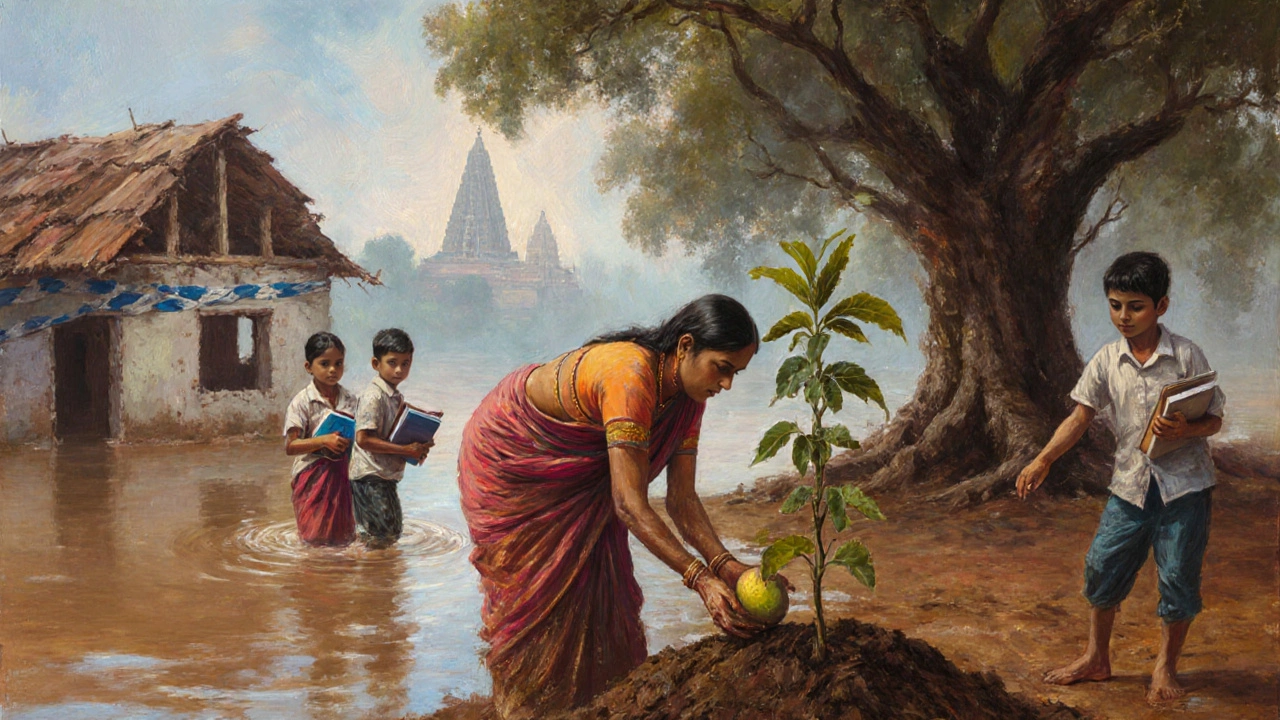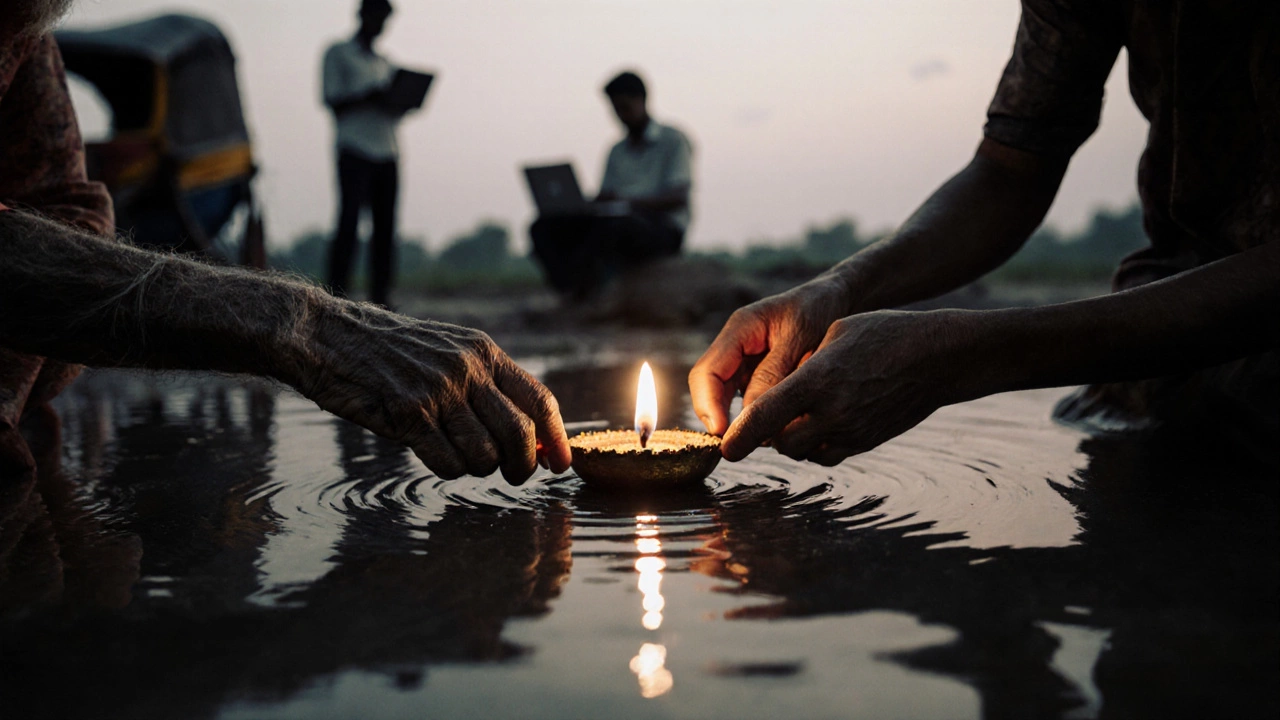Resilience Reflection Tool
Discover Your Resilience Style
India's spirit lives in quiet persistence through centuries of challenges. This tool helps you reflect on your own resilience as inspired by India's enduring strength.
When facing a major setback, what's your first instinct?
When you see someone struggling, how do you respond?
What matters most to you in difficult times?
Your Resilience Reflection
What this means:
Your resilience style reflects —a quality deeply rooted in India's enduring spirit. Like the farmers who plant again after drought, or the women who run startups while carrying water, your approach shows that resilience isn't about grand gestures. It's in the quiet persistence you bring to daily life.
Ask someone to define India in one word, and they’ll pause. Not because they don’t know, but because any single word feels like trying to hold the ocean in a teacup. India isn’t just a country on a map. It’s a thousand languages spoken at once. A temple bell ringing beside a smartphone notification. A grandmother’s prayer whispered over steaming chai, while a teenager livestreams from a rooftop in Mumbai. It’s chaos and calm, ancient and futuristic-all breathing in the same air.
It’s Not One Word. It’s a Whisper That Echoes
If you push for one word, most people will say ‘diversity.’ But that’s not enough. Diversity is a description, not a feeling. India doesn’t just have diversity-it lives it. In the Himalayas, monks chant in Tibetan while farmers in Odisha harvest rice using tools unchanged for 500 years. In Bengal, poets recite Tagore under banyan trees. In Kerala, women perform Theyyam dances that honor spirits older than recorded history. In Delhi, a street vendor sells samosas next to a startup coding AI for rural healthcare.
This isn’t tolerance. It’s coexistence so deep, it’s invisible. You don’t notice it because it’s the air you breathe. You wake up to a call to prayer, eat a vegan thali for breakfast, and later hear a Bollywood remix of a 17th-century raga. No other place on Earth holds that many contradictions without exploding. India doesn’t resolve them. It lets them sit together, quietly, like family members who argue but never leave.
The Word That Fits: ‘Resilience’
If you must pick one word, it’s ‘resilience.’ Not because India is tough. But because it refuses to be broken.
Think about it. Colonized for 200 years. Partitioned in 1947 with over a million dead. Floods that swallow entire villages. Earthquakes that crush cities. Yet, the same hands that rebuild homes also plant mango trees. The same children who walk five kilometers to school carry textbooks stitched together with tape. The same women who carry water on their heads also run billion-dollar startups.
Resilience here isn’t loud. It doesn’t wear a medal. It’s in the way a widow in Varanasi still lights a diya every evening for her husband, even though the river has taken him. It’s in the rickshaw driver who saves ₹50 a day to send his daughter to engineering college. It’s in the farmer who loses his crop to drought, but plants again the next season-not because he’s hopeful, but because giving up isn’t an option in his bloodline.
Resilience isn’t about surviving. It’s about remembering who you are while everything else changes. India has seen empires rise and fall. It’s been ruled by kings, emperors, and corporations. Yet, the rhythm of its people hasn’t changed. They still wake before dawn. Still bow to elders. Still share food with strangers. Still believe in karma, not because they’re religious, but because it makes sense in a world that often doesn’t.

What India Isn’t
India isn’t the Bollywood fantasy. It’s not just saris and elephants. It’s not the poverty porn on foreign documentaries. It’s not the temple selfies or the yoga poses sold as spiritual products.
India is the silence between the noise. The pause before a mother scolds her child for wasting food. The way a stranger in a crowded train offers you half his banana without saying a word. The way a man in a village fixes a broken well with his bare hands because no one else will.
It’s not about grand gestures. It’s about tiny acts of stubborn love. The kind that doesn’t need applause. That doesn’t get posted on Instagram. That doesn’t make headlines. But keeps the whole thing alive.

The Language of India Is in the Unspoken
Try asking an Indian how they’re doing. They’ll say, ‘I’m fine.’ Even if they’re not. Not because they’re lying. But because ‘fine’ is a shield. A way to protect the other person from their burden. That’s India. You don’t ask for help. You don’t announce pain. You just keep going. And if someone notices? They’ll bring you tea. Not with words. With silence and warmth.
This is why the West struggles to understand India. They look for logic. For systems. For efficiency. India operates on something else: connection. Not transactional. Not measurable. But emotional. Spiritual. Deeply human.
That’s why a 70-year-old woman in Rajasthan will give you her last roti, even if she hasn’t eaten all day. Not because she’s saintly. But because in her world, feeding someone is how you say, ‘You matter.’
India Is a Living Question
You can’t define India. You can only experience it. And even then, it changes depending on where you stand.
Stand in a Mumbai slum, and you’ll see poverty that breaks your heart. But you’ll also see kids studying under streetlights, their notebooks filled with dreams written in pencil. Stand in a corporate office in Bangalore, and you’ll see engineers designing satellites. But you’ll also see them praying at their desks before a big meeting, lighting incense beside their laptops.
India doesn’t fit into boxes. It refuses to. It’s not a country that wants to be understood. It just wants to be felt.
So if you’re still searching for that one word… don’t look for it in books. Look in the eyes of the person serving you food. In the hands of the woman cleaning your hotel room. In the voice of the child singing a song in a dialect you’ve never heard.
That’s India. Not a word. A heartbeat.
Can India really be defined in one word?
No-not truly. Any single word like ‘diversity,’ ‘spirituality,’ or ‘chaos’ only captures a fragment. India is too vast, too layered, too alive to be reduced. But if you had to choose one word that holds its soul, ‘resilience’ comes closest. It’s not about strength alone. It’s about continuing, quietly, even when everything falls apart. That’s the rhythm of India.
Why do people say India is spiritual?
Because spirituality here isn’t something you practice. It’s something you live. It’s in the morning prayer before breakfast, the way food is offered to a tree before eating, the silence before a bus ride, the belief that everything is connected. You don’t need a temple to feel it. You feel it in the way strangers help each other without being asked. Spirituality in India isn’t about rituals. It’s about presence.
Is India’s resilience just a myth?
No. It’s documented in everyday life. After the 2001 Gujarat earthquake, villages rebuilt their homes with their own hands, using mud and memory. After the 2020 pandemic lockdowns, street vendors shared food with migrants stranded on highways. Resilience here isn’t heroic. It’s ordinary. And that’s why it lasts. It’s not about surviving disasters. It’s about refusing to let them erase your humanity.
What’s the biggest misunderstanding about India?
That it’s a place that needs fixing. Outsiders often see poverty, overcrowding, or corruption-and assume India needs to become ‘like the West.’ But India doesn’t need to change to be valuable. Its power lies in its contradictions. Its ability to hold ancient traditions and cutting-edge tech in the same breath. The real mistake is thinking progress means losing your soul. India proves you can have both.
Why do Indians seem so calm in chaos?
Because they’ve lived with chaos for generations. It’s not that they’re not stressed. They are. But they’ve learned that reacting loudly doesn’t fix anything. Calm isn’t indifference. It’s strategy. It’s knowing that if you lose your temper, you lose your power. So they wait. They adapt. They find space in the noise. That’s not passivity. That’s deep wisdom.
